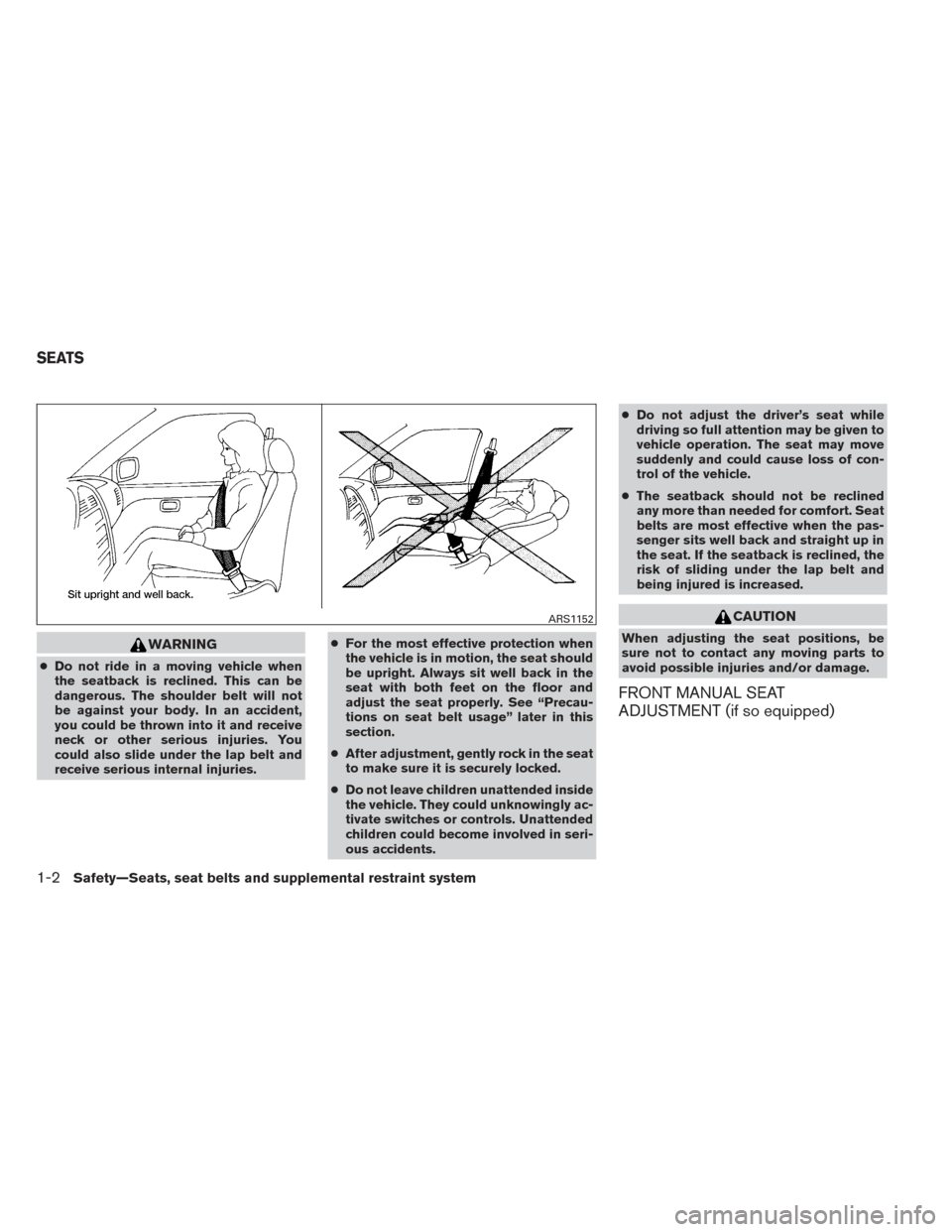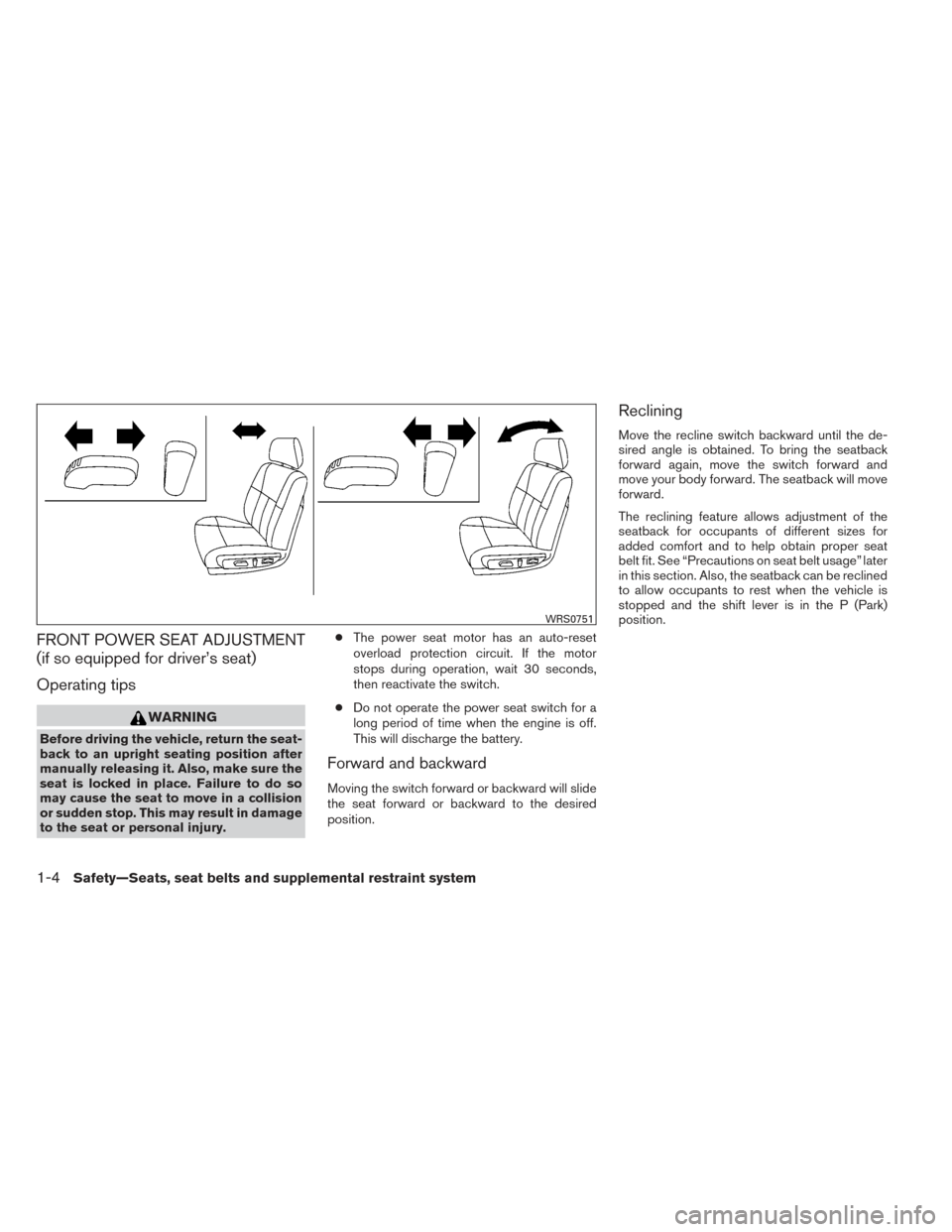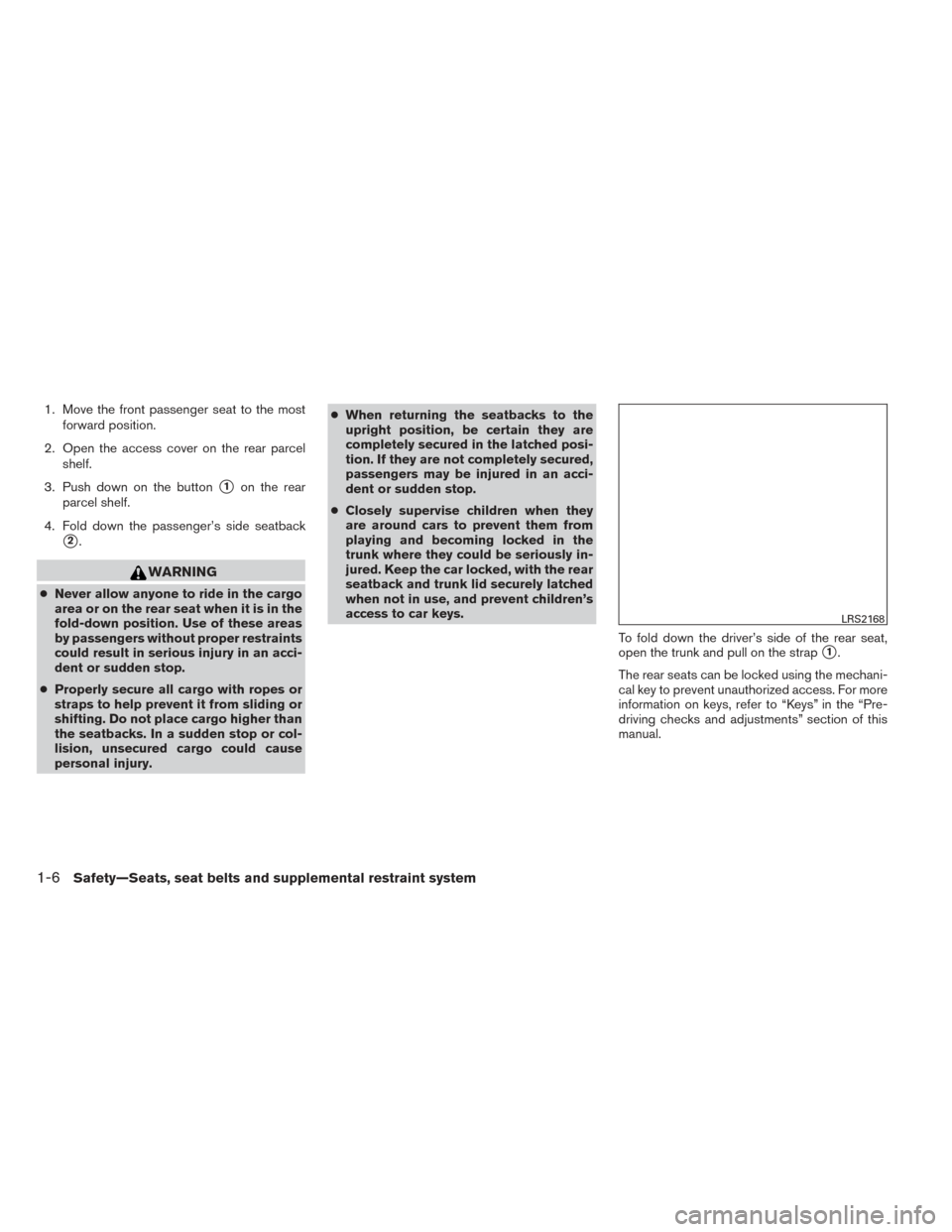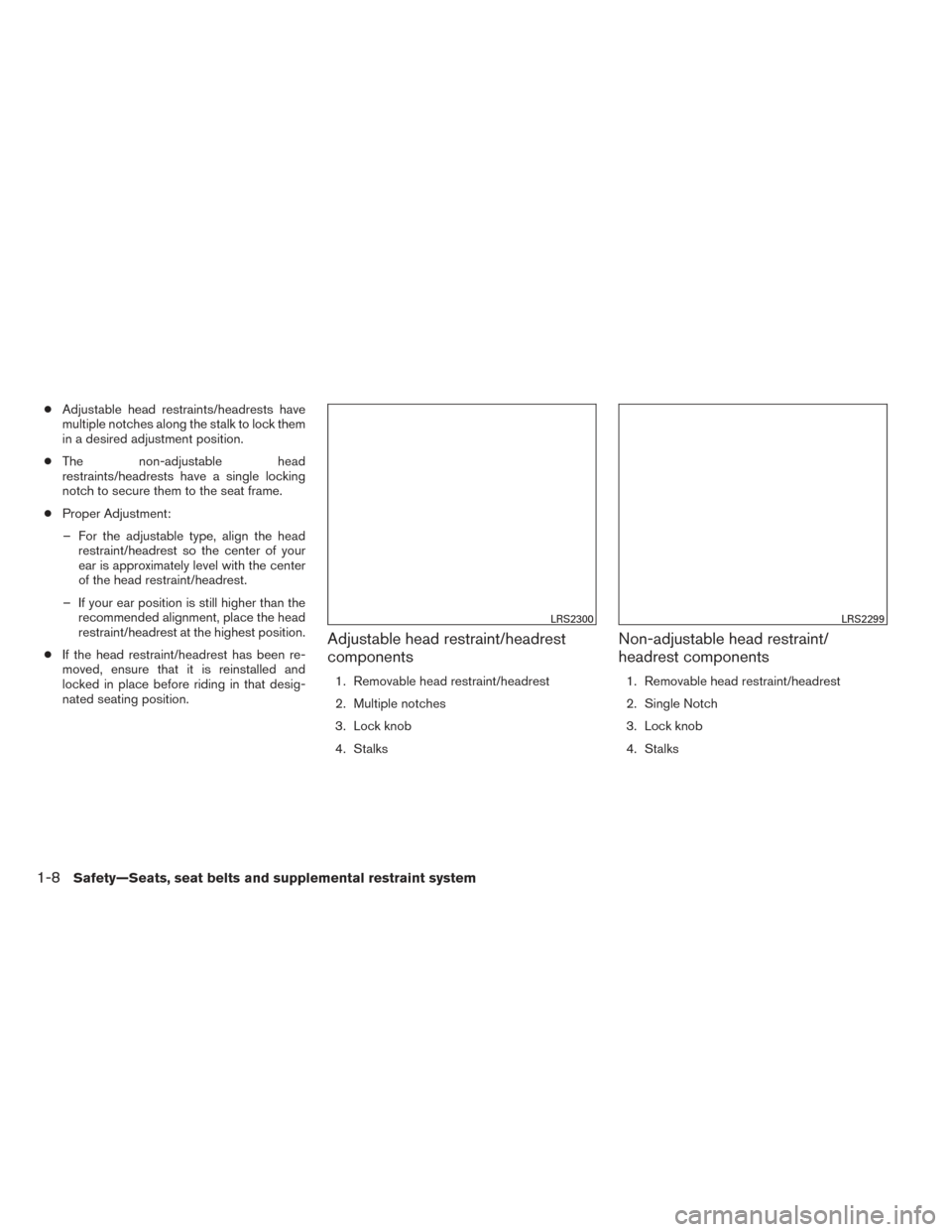Page 10 of 428
1. Power windows (P. 2-43)
2. Windshield (P. 8-21)
3. Windshield wiper and washer switch(P. 2-29)
4. Engine hood (P. 3-28)
5. Tie down (P. 6-12)
6. Fog light switch (if so equipped)
P. 2-30)
7. Headlight and turn signal switch
(P. 2-31)
8. Replacing bulbs (P. 8-28)
9. Tire pressure (P. 8-36)
10. Flat tire (P. 6-3)
11. Tire chains (P. 8-44)
12. Mirrors (P. 3-35)
13. Door locks, NISSAN Intelligent Key® ,
keys (P. 3-4, 3-7, 3-2)
See the page number indicated in paren-
theses for operating details.
LII2038
EXTERIOR FRONT
Illustrated table of contents0-3
Page 11 of 428
1. Rear window defroster switch (P. 2-30)
2. Interior trunk lid release (P. 3-30)
3. Trunk lid (P. 3-28)
4. Opener operation (P. 3-28)
5. Replacing bulbs (P. 8-28)
6. Fuel-filler cap, fuel recommendation(P. 3-31, P. 9-3)
7. Fuel-filler door (P. 3-31)
8. Child safety rear door lock (P. 3-7)
See the page number indicated in paren-
theses for operating details.
LII2039
EXTERIOR REAR
0-4Illustrated table of contents
Page 17 of 428
Warninglight Name Page
Anti-lock Braking
System (ABS) warn-
ing light 2-11
or
Brake warning light 2-11
Charge warning
light
2-11
Low tire pressure
warning light2-12
Master warning light 2-13
Power steering
warning light2-13
Seat belt warning
light and chime2-14
Warning
light Name Page
Supplemental air
bag warning light 2-14
Indicator
light Name Page
Fog light indicator
light (if so equipped) 2-14
Front passenger air
bag status light2-14
High beam indicator
light (blue)2-14
Malfunction Indica-
tor Light (MIL)2-15
Overdrive off indica-
tor light (if so
equipped)2-15
Security indicator
light
2-16
Indicator
light Name Page
Side light and head-
light indicator light
(green) 2-16
Slip indicator light 2-16
SPORT mode indi-
cator light (if so
equipped)2-14
Turn signal/hazard
indicator lights
2-16
Vehicle Dynamic
Control (VDC) off
indicator light2-16
WARNING/INDICATOR LIGHTS
0-10Illustrated table of contents
Page 19 of 428

WARNING
●Do not ride in a moving vehicle when
the seatback is reclined. This can be
dangerous. The shoulder belt will not
be against your body. In an accident,
you could be thrown into it and receive
neck or other serious injuries. You
could also slide under the lap belt and
receive serious internal injuries. ●
For the most effective protection when
the vehicle is in motion, the seat should
be upright. Always sit well back in the
seat with both feet on the floor and
adjust the seat properly. See “Precau-
tions on seat belt usage” later in this
section.
● After adjustment, gently rock in the seat
to make sure it is securely locked.
● Do not leave children unattended inside
the vehicle. They could unknowingly ac-
tivate switches or controls. Unattended
children could become involved in seri-
ous accidents. ●
Do not adjust the driver’s seat while
driving so full attention may be given to
vehicle operation. The seat may move
suddenly and could cause loss of con-
trol of the vehicle.
● The seatback should not be reclined
any more than needed for comfort. Seat
belts are most effective when the pas-
senger sits well back and straight up in
the seat. If the seatback is reclined, the
risk of sliding under the lap belt and
being injured is increased.
CAUTION
When adjusting the seat positions, be
sure not to contact any moving parts to
avoid possible injuries and/or damage.
FRONT MANUAL SEAT
ADJUSTMENT (if so equipped)
ARS1152
SEATS
1-2Safety—Seats, seat belts and supplemental restraint system
Page 20 of 428
Forward and backward
Pull the center of the bar up and hold it while you
slide the seat forward or backward to the desired
position. Release the bar to lock the seat in
position.
Reclining
To recline the seatback, pull the lever up and lean
back. To bring the seatback forward, pull the lever
up and lean your body forward. Release the lever
to lock the seatback in position.
The reclining feature allows adjustment of the
seatback for occupants of different sizes for
added comfort and to help obtain proper seat
belt fit. See “Precautions on seat belt usage” later
in this section. Also, the seatback can be reclined
to allow occupants to rest when the vehicle is
stopped and the shift lever is in the P (Park)
position.
Seat lifter (if so equipped for driver’s
seat)
Pull up or push down the adjusting lever to adjust
the seat height until the desired position is
achieved.
LRS2160LRS2161WRS0740
Safety—Seats, seat belts and supplemental restraint system1-3
Page 21 of 428

FRONT POWER SEAT ADJUSTMENT
(if so equipped for driver’s seat)
Operating tips
WARNING
Before driving the vehicle, return the seat-
back to an upright seating position after
manually releasing it. Also, make sure the
seat is locked in place. Failure to do so
may cause the seat to move in a collision
or sudden stop. This may result in damage
to the seat or personal injury.●
The power seat motor has an auto-reset
overload protection circuit. If the motor
stops during operation, wait 30 seconds,
then reactivate the switch.
● Do not operate the power seat switch for a
long period of time when the engine is off.
This will discharge the battery.
Forward and backward
Moving the switch forward or backward will slide
the seat forward or backward to the desired
position.
Reclining
Move the recline switch backward until the de-
sired angle is obtained. To bring the seatback
forward again, move the switch forward and
move your body forward. The seatback will move
forward.
The reclining feature allows adjustment of the
seatback for occupants of different sizes for
added comfort and to help obtain proper seat
belt fit. See “Precautions on seat belt usage” later
in this section. Also, the seatback can be reclined
to allow occupants to rest when the vehicle is
stopped and the shift lever is in the P (Park)
position.
WRS0751
1-4Safety—Seats, seat belts and supplemental restraint system
Page 23 of 428

1. Move the front passenger seat to the mostforward position.
2. Open the access cover on the rear parcel shelf.
3. Push down on the button
�1on the rear
parcel shelf.
4. Fold down the passenger’s side seatback
�2.
WARNING
● Never allow anyone to ride in the cargo
area or on the rear seat when it is in the
fold-down position. Use of these areas
by passengers without proper restraints
could result in serious injury in an acci-
dent or sudden stop.
● Properly secure all cargo with ropes or
straps to help prevent it from sliding or
shifting. Do not place cargo higher than
the seatbacks. In a sudden stop or col-
lision, unsecured cargo could cause
personal injury. ●
When returning the seatbacks to the
upright position, be certain they are
completely secured in the latched posi-
tion. If they are not completely secured,
passengers may be injured in an acci-
dent or sudden stop.
● Closely supervise children when they
are around cars to prevent them from
playing and becoming locked in the
trunk where they could be seriously in-
jured. Keep the car locked, with the rear
seatback and trunk lid securely latched
when not in use, and prevent children’s
access to car keys.
To fold down the driver’s side of the rear seat,
open the trunk and pull on the strap
�1.
The rear seats can be locked using the mechani-
cal key to prevent unauthorized access. For more
information on keys, refer to “Keys” in the “Pre-
driving checks and adjustments” section of this
manual.
LRS2168
1-6Safety—Seats, seat belts and supplemental restraint system
Page 25 of 428

●Adjustable head restraints/headrests have
multiple notches along the stalk to lock them
in a desired adjustment position.
● The non-adjustable head
restraints/headrests have a single locking
notch to secure them to the seat frame.
● Proper Adjustment:
– For the adjustable type, align the head restraint/headrest so the center of your
ear is approximately level with the center
of the head restraint/headrest.
– If your ear position is still higher than the recommended alignment, place the head
restraint/headrest at the highest position.
● If the head restraint/headrest has been re-
moved, ensure that it is reinstalled and
locked in place before riding in that desig-
nated seating position.
Adjustable head restraint/headrest
components
1. Removable head restraint/headrest
2. Multiple notches
3. Lock knob
4. Stalks
Non-adjustable head restraint/
headrest components
1. Removable head restraint/headrest
2. Single Notch
3. Lock knob
4. Stalks
LRS2300LRS2299
1-8Safety—Seats, seat belts and supplemental restraint system